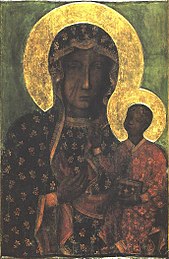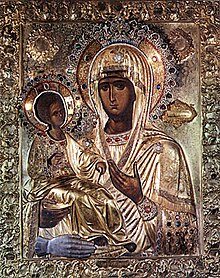Black Madonna
Important early studies of dark-skinned holy images in France were by Camille Flammarion (1888),[4] Marie Durand-Lefebvre (1937), Emile Saillens (1945), and Jacques Huynen (1972).
The first notable study in English of the origin and meaning of the Black Madonnas appears to have been presented by Leonard Moss at a meeting of the American Association for the Advancement of Science on December 28, 1952.
Moss divided the images into three categories: (1) dark brown or black Madonnas with physiognomy and skin pigmentation matching that of the indigenous population; (2) various art forms that have turned black as a result of certain physical factors such as deterioration of lead-based pigments, accumulated smoke from the use of votive candles, and accumulation of grime over the ages, and (3) miracle-worker Madonnas, the focus of the study, Black Madonnas found in areas of a Roman legion and, therefore, not a reflection of the current population's skin colour.
[3] In the cathedral at Chartres, there were two Black Madonnas: Notre Dame de Pilar, a 1508 dark walnut copy of a 13th-century silver Madonna, standing atop a high pillar, surrounded by candles; and Notre Dame de Sous-Terre, a replica of an original destroyed during the French Revolution.
[7] TROJA CHATEAU chapel- original "Montserrat Madonna" from Old Town Byzantine building (pg.100 of Martin Krummholz ISBN 978-80-7010-131-5)





















